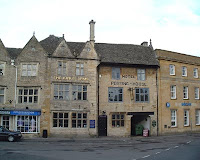(Vanished) House of the Week!
 Yes, that's it. Eight pairs of elaborate gate piers and part of a walled garden are all that is left of the First Earl of Craven's splendid house at Hamstead Marshall in Berkshire, yet despite that the site is one of the most fascinating and atmospheric places to visit, perhaps because you can let your imagination run riot. There are pieces of roof slates, floor tiles and window glass still lying in the fields as testament to the magnificence of the house and you can walk across the whole area, imagining that you are strolling in the pleasure grounds. Aerial photographs still clearly show the outlines of the parterre and box gardens and the foundation line of the front of the house.
Yes, that's it. Eight pairs of elaborate gate piers and part of a walled garden are all that is left of the First Earl of Craven's splendid house at Hamstead Marshall in Berkshire, yet despite that the site is one of the most fascinating and atmospheric places to visit, perhaps because you can let your imagination run riot. There are pieces of roof slates, floor tiles and window glass still lying in the fields as testament to the magnificence of the house and you can walk across the whole area, imagining that you are strolling in the pleasure grounds. Aerial photographs still clearly show the outlines of the parterre and box gardens and the foundation line of the front of the house.The house was built by Sir Balthazar Gerbier in the early 1660s, modelled on Elizabeth of  Bohemia's palace at Heidelberg. It burned down in 1718, only 21 years after the first Earl's death. Some of the design paperwork survives today in the form of 40 drawings in the Bodleian Library. They show designs for gateways, porticos and some very grand stabling, ceilings and window ornaments. They also show a floor which contains no fewer than 30 rooms, each with its own purpose such as “Withdrawing room to repaire the records”, “Roome to repose after Bathing” and separate accommodations for the Distiller, the Spicery, the Confectioner and the Lardery.
Bohemia's palace at Heidelberg. It burned down in 1718, only 21 years after the first Earl's death. Some of the design paperwork survives today in the form of 40 drawings in the Bodleian Library. They show designs for gateways, porticos and some very grand stabling, ceilings and window ornaments. They also show a floor which contains no fewer than 30 rooms, each with its own purpose such as “Withdrawing room to repaire the records”, “Roome to repose after Bathing” and separate accommodations for the Distiller, the Spicery, the Confectioner and the Lardery.
 Bohemia's palace at Heidelberg. It burned down in 1718, only 21 years after the first Earl's death. Some of the design paperwork survives today in the form of 40 drawings in the Bodleian Library. They show designs for gateways, porticos and some very grand stabling, ceilings and window ornaments. They also show a floor which contains no fewer than 30 rooms, each with its own purpose such as “Withdrawing room to repaire the records”, “Roome to repose after Bathing” and separate accommodations for the Distiller, the Spicery, the Confectioner and the Lardery.
Bohemia's palace at Heidelberg. It burned down in 1718, only 21 years after the first Earl's death. Some of the design paperwork survives today in the form of 40 drawings in the Bodleian Library. They show designs for gateways, porticos and some very grand stabling, ceilings and window ornaments. They also show a floor which contains no fewer than 30 rooms, each with its own purpose such as “Withdrawing room to repaire the records”, “Roome to repose after Bathing” and separate accommodations for the Distiller, the Spicery, the Confectioner and the Lardery.According to Penelope Stokes in her excellent History of Hamstead Marshall, the surviving gate piers have attracted admiration and derision in equal measure:
Lysons, in Magna Britannica (1813): “Some clumsy brick piers which remain in the park, ornamented with sphinxes and gryphons, afford but an unfavourable specimen of the architect’s taste.”
Oliver Hill and John Cornforth in English Country Houses (1966): “..a sense of vanished magnificence expressed in the richly decorated but isolated gate piers which now rise from a pastoral landscape setting.”
I prefer the latter description. I love a romantic ruin and a walk around Hamstead Park conjures the ghosts of the past.
Oliver Hill and John Cornforth in English Country Houses (1966): “..a sense of vanished magnificence expressed in the richly decorated but isolated gate piers which now rise from a pastoral landscape setting.”
I prefer the latter description. I love a romantic ruin and a walk around Hamstead Park conjures the ghosts of the past.



Comments